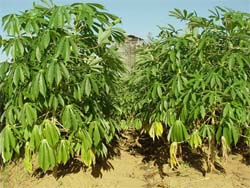
A comparison between transgenic cassava species (left) and a regular one (right).
A pioneer study on field test of transgenic cassava (
Manihot esculenta Crantz) by a Sino-Swiss research consortium has proved successful. The experiment was carried out in 2006 at an experimental station in Haikou, capital of south China's Hainan Province.
The experiment is a joint effort conducted by cassava scientists from the Institute of Plant Physiology and Ecology (SIPPE), Shanghai Institutes for Biological Sciences, Chinese Academy of Sciences and the Institute of Tropical Biosciences and Biotechnology, Chinese Academy of Tropical Agricultural Sciences and the Institute of Plant Sciences, ETH Zurich.
Cassava is an important root crop in the tropics and subtropics where it is traditionally processed for food, starch and alcoholic beverages. Now cassava has been considered an important biomass for bioethanol production with an enormous potential. Recently, worldwide research collaborations on cassava biotechnology have been promoted by international foundations, such as the Grand Challenges Program (GC9) of the Bill and Melinda Gates Foundation. As a research team of GC9 Program, the BioCassava Plus Project is organizing a dozen prestigious research institutions across the world to solve several key problems of cassava in Africa. Prof. Peng Zhang from SIPPE is one of the participant scientists.
As a result of five year-long research, Zhang and his colleagues have established a reproducible system for cassava genetic transformation. By transforming cassava plants with a cytokinin biosynthesis gene under the control of leaf senescence specific promoter, cassava could be effectively prevent or delay leaf shedding. Therefore, cassava could have increased photosynthesis capacity, leading to a higher yield of its edible tuber.
Upon the approval of Chinese Ministry of Agriculture, the field experiment of the transgenic cassava was launched in January 2006. "Although several groups have reported the production of transgenic cassava with reduced toxic level of cyanogenic glucosides in the tuber, increased resistance against African cassava mosaic virus and enhanced starch production, they are still kept in laboratories," Prof. Zhang addressed.





